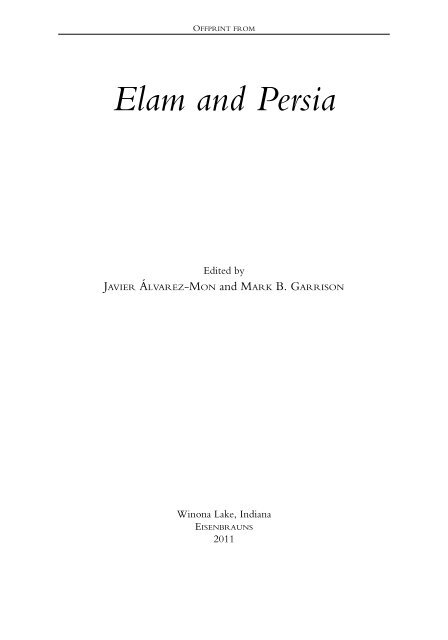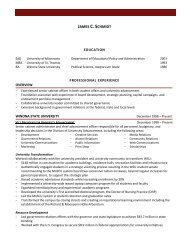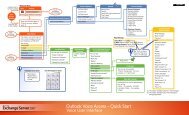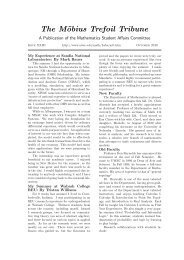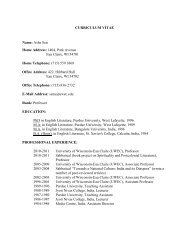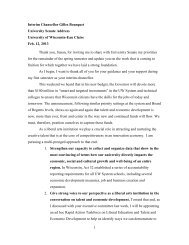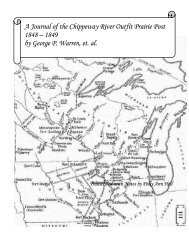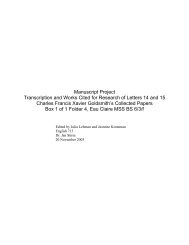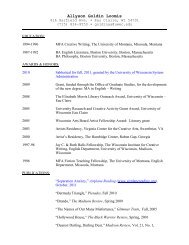Elam and Persia - University of Wisconsin-Eau Claire
Elam and Persia - University of Wisconsin-Eau Claire
Elam and Persia - University of Wisconsin-Eau Claire
Create successful ePaper yourself
Turn your PDF publications into a flip-book with our unique Google optimized e-Paper software.
OFFPRINT<br />
FROM<br />
<strong>Elam</strong> <strong>and</strong> <strong>Persia</strong><br />
Edited by<br />
Javier Álvarez-Mon <strong>and</strong> Mark B. Garrison<br />
Winona Lake, Indiana<br />
Eisenbrauns<br />
2011
ç Copyright 2011 by Eisenbrauns.<br />
All rights reserved.<br />
Printed in the United States <strong>of</strong> America.<br />
www.eisenbrauns.com<br />
Library <strong>of</strong> Congress Cataloging-in-Publication Data<br />
<strong>Elam</strong> <strong>and</strong> <strong>Persia</strong> / edited by Javier Álvarez-Mon <strong>and</strong> Mark B. Garrison<br />
p. cm.<br />
Includes papers from a meeting <strong>of</strong> the American Schools <strong>of</strong> Oriental Research, held<br />
in Philadelphia, Pa., 2003.<br />
Includes bibliographical references.<br />
ISBN 978-1-57506-166-5 (hbk. : alk. paper)<br />
1. <strong>Elam</strong>—Civilization—Congresses. 2. <strong>Elam</strong>—Antiquities—Congresses.<br />
3. Philology—<strong>Elam</strong>—History—Congresses. 4. Art, <strong>Elam</strong>ite—History—<br />
Congresses. 5. Fars (Iran)—Civilization—Congresses. 7. Philology—Iran—<br />
Fars—Congresses. 8. Art, Iranian—Iran—Fars—History—Congresses.<br />
9. <strong>Elam</strong>—Relations—Iran—Fars—Congresses. 10. Fars (Iran)—Relations—<br />
<strong>Elam</strong>—Congresses. I. Álvarez-Mon, Javier. II. Garrison, Mark B.<br />
III. American Schools <strong>of</strong> Oriental Research. Meeting (2003 : Philadelphia, Pa.)<br />
DS65.E43 2010<br />
935—dc22 2010035003<br />
The paper used in this publication meets the minimum requirements <strong>of</strong> the American National<br />
St<strong>and</strong>ard for Information Sciences—Permanence <strong>of</strong> Paper for Printed Library Materials, ANSI<br />
Z39.48-1984. †‘
Parsumas, Ansan, <strong>and</strong> Cyrus<br />
Matt Waters<br />
<strong>University</strong> <strong>of</strong> <strong>Wisconsin</strong>–<strong>Eau</strong> <strong>Claire</strong><br />
§1. Introduction; §2. Parsuas, Parsumas, <strong>and</strong> Parsua; §3. Ansan; §4. Ansan <strong>and</strong> Parsu(m)as;<br />
§5. Cyrus’s Line.<br />
1. Introduction<br />
The evidence for Cyrus the Great’s rise is varied <strong>and</strong> convoluted <strong>and</strong>, as a consequence, riddled<br />
with problems <strong>of</strong> use <strong>and</strong> interpretation. Under consideration here are some questions <strong>of</strong><br />
historical geography involving the toponyms Parsu(m)as, Ansan, <strong>and</strong> <strong>Elam</strong> in conjunction with<br />
the identification <strong>of</strong> Cyrus <strong>of</strong> Parsumas <strong>and</strong> Cyrus I, gr<strong>and</strong>father <strong>of</strong> Cyrus the Great. The<br />
chronological frame <strong>of</strong> the focal evidence considered runs roughly two hundred <strong>and</strong> thirty<br />
years from Sargon II (reigned 721–705 b.c.) to Darius I (reigned 522–486 b.c.). The various<br />
str<strong>and</strong>s <strong>of</strong> this evidence are too ambiguous to reconcile conclusively, so this essay is by necessity<br />
interpretive.<br />
The progression <strong>of</strong> the <strong>Persia</strong>ns into Fars, <strong>and</strong> their mixing with the <strong>Elam</strong>ites, is something<br />
about which little is known, even if a general outline is possible. 1 Archaeological evidence is as<br />
yet too meager to solve many <strong>of</strong> the questions reconsidered here. The primary question remains:<br />
How do we explain the rapid rise <strong>of</strong> the <strong>Persia</strong>n Empire from its origins in the kingdom<br />
<strong>of</strong> Ansan, based at a city (<strong>of</strong> the same name) in a plain for which there is no attested settlement<br />
from roughly 1000 b.c. to the beginning <strong>of</strong> the Achaemenid period? 2 The prevailing assumption<br />
is that this area <strong>of</strong> Fars, if not the entire region, was inhabited by pastoralists. This assumption—at<br />
a superficial level—agrees with Herodotus <strong>and</strong> other classical writers’ portrayal <strong>of</strong> the<br />
<strong>Persia</strong>ns as a tribal-based society. 3 By most accounts, <strong>Persia</strong>ns are attested archaeologically from<br />
the mid-7th century onward, <strong>and</strong> their ethnogenesis via acculturation with the <strong>Elam</strong>ites may<br />
be tracked in a number <strong>of</strong> sporadic, but compelling, ways. 4<br />
1. See, among others, Miroschedji 1985, 1990, 2003; Potts 1999, 2005; Sumner 1986, 1994, 1987, especially<br />
314 (whereas the Malyan period 900–600 is marked: “Hiatus?”); Carter 1994; Henkelman 2003a; Stronach<br />
2003a; Curtis 2005.<br />
The problems discussed in this paper have a long history in modern scholarship. Rather than attempt to be<br />
exhaustive, I instead <strong>of</strong>fer representative references to particular problems, especially those that contain more<br />
extensive bibliography. I acknowledge <strong>and</strong> thank Dan Potts <strong>and</strong> Mark Garrison for sharing copies <strong>of</strong> their forthcoming<br />
works. I also thank the American Council <strong>of</strong> Learned Societies <strong>and</strong> the <strong>University</strong> <strong>of</strong> <strong>Wisconsin</strong>–<strong>Eau</strong><br />
<strong>Claire</strong> for research support. Abbreviations follow The Chicago Assyrian Dictionary <strong>of</strong> the Oriental Institute <strong>of</strong> the<br />
<strong>University</strong> <strong>of</strong> Chicago (CAD), unless otherwise noted.<br />
2. Note Potts’s (2005: 21) cautionary remark that much <strong>of</strong> the site <strong>and</strong> wider area remains to be explored.<br />
See also Sumner 1986: 7–12 <strong>and</strong> 1994: 101–105.<br />
3. Hdt. I.125; see discussion at Briant 2002: 18–19.<br />
4. Miroschedji 2003: 35 <strong>and</strong> Henkelman 2003a (both with references).<br />
285<br />
Offprint from:<br />
Javier Álvarez-Mon <strong>and</strong> Mark B. Garrison, eds.,<br />
<strong>Elam</strong> <strong>and</strong> <strong>Persia</strong><br />
ç Copyright 2011 Eisenbrauns. All rights reserved.
286<br />
Matt Waters<br />
2. Parsuas, Parsumas, <strong>and</strong> Parsua<br />
It is assumed herein that the toponym Parsu(m)as used in relation to modern Fars represented<br />
an ethnically <strong>Persia</strong>n element dwelling within, an element to which use <strong>of</strong> that toponym<br />
referred. The variant spellings Parsuas, Parsumas, or Parsua themselves do not differentiate<br />
whether Parsu(m)a(s) <strong>of</strong> the Neo-Assyrian Zagros or Parsu(m)as <strong>of</strong> Fars is in question—only<br />
context differentiates the two. Parsua, as a full-fledged Assyrian province in the Zagros, is <strong>of</strong><br />
course more prominent in the source material. In textual sources, the toponym Parsu(m)as—<br />
for a presumably (though not necessarily exclusively) <strong>Persia</strong>n entity in Fars 5 —has been traced<br />
back into Sennacherib’s reign, <strong>and</strong> there is strong reason to extend that usage into Sargon’s<br />
reign as well. A Neo-Assyrian letter, author’s name broken but restored as Nabû-duru-ußur, refers<br />
to a messenger <strong>of</strong> the <strong>Elam</strong>ite king having been sent to Parsumas to determine if someone<br />
(the name is broken but ends in yâ) will mobilize troops. The historical context <strong>of</strong> this letter is<br />
the Assyrian-<strong>Elam</strong>ite struggle over Ellipi in <strong>and</strong> after 708 b.c. It is unlikely, if not impossible,<br />
that the king <strong>of</strong> <strong>Elam</strong> (Sutruk-Nahhunte II) was able to recruit troops from the Assyrian province<br />
<strong>of</strong> Parsua, so this reference should be taken to mean Parsumas in Fars. 6 That troops from<br />
both Parsuas <strong>and</strong> Ansan stood with Huban-menanu at the Battle <strong>of</strong> Halule in 691 b.c. <strong>of</strong>fers<br />
suitable context for what most assume anyway: the <strong>Elam</strong>ites were already in close contact with<br />
<strong>Persia</strong>ns in Fars, even if there exist only echoes <strong>of</strong> this contact in Assyrian sources.<br />
3. Ansan<br />
Consideration <strong>of</strong> the textual sources for Ansan complicates the issue. Occurrences in Neo-<br />
Assyrian texts are rare: the much-discussed listing in Sennacherib’s inventory <strong>of</strong> those regions<br />
that supplied troops to Huban-menanu before Halule <strong>and</strong> a broken reference to Ansanites in<br />
the so-called “Epic <strong>of</strong> Sargon.” 7 This intriguing text is too fragmentary to discern much else,<br />
but if its attribution to Sargon is correct (so followed here), its content appears to refer to Sargon’s<br />
victory over a broad-ranging coalition that included men from Ansan. Emphasis on<br />
<strong>Elam</strong>, the <strong>Elam</strong>ite bow, <strong>and</strong> Ellipi (rev. 8u–13u) also points to the Assyrian-<strong>Elam</strong>ite struggle in<br />
Ellipi in the late 8th century b.c. If Huban-menanu was able to assemble troops (through whatever<br />
means) from Ansan <strong>and</strong> Parsuas, it would be no surprise that Sutruk-Nahhunte was able<br />
to do so as well, at least as indirectly implied by this text <strong>and</strong> the Neo-Assyrian letter discussed<br />
above. 8 The broken <strong>and</strong> opaque passage in the “Epic <strong>of</strong> Sargon” may lend some indirect sup-<br />
5. The variant Parsua, to my knowledge, the Assyrians did not use to indicate Fars. Note Fuchs 2004. See<br />
for text references Parpola 1970: 274–75 <strong>and</strong> Zadok 1985: 247–48. It should be remembered that Parsu(m)as<br />
in Fars included other ethnic groups, especially <strong>Elam</strong>ites. In ABL 1311+ (from the time <strong>of</strong> Ashurbanipal), line<br />
23, Parsumas occurs both to identify a place <strong>and</strong> people; the determinatives are restored in both cases, but the<br />
second instance is spelled with the –ú-a gentilic; De Vaan 1995: 311. Instead <strong>of</strong> “<strong>Persia</strong>ns,” one could translate<br />
“Parsumasians” in this <strong>and</strong> similar cases, but to do so would be excessively pedantic. For discussion, cf. Waters<br />
1999; Rollinger 1999; Zadok 2001. For Urartian B/Parsua, see Lanfranchi 2003: 101–2 n. 97.<br />
6. Fuchs <strong>and</strong> Parpola 2001: no. 129, xxxiii <strong>and</strong> liii n. 102; note also discussion <strong>and</strong> references xxiv–xxxi.<br />
For Nabû-duru-ußur, an <strong>of</strong>ficial in the Assyrian administration <strong>of</strong> Babylonia, see Baker 2001: 824.<br />
7. For the Sennacherib listing regarding the Battle <strong>of</strong> Halule, see Luckenbill 1924: 43, lines 43–44, 88. line<br />
44, <strong>and</strong> 91, rev. 9; Grayson 1963: 94–95, line 110; Frahm 1997: 207–8, line 15 (K 2622). I thank Bob Whiting<br />
for searching the SAA database for occurrences <strong>of</strong> “Anzan” on my behalf. The “Epic <strong>of</strong> Sargon” (81-2-4,320)<br />
rev. 14u reads: [preceding broken] an-za-nu-ú-a; see Livingstone 1989: no. 18.<br />
8. Cf. Fuchs <strong>and</strong> Parpola 2001: xxxiii.<br />
spread is 6 points long<br />
Offprint from:<br />
Javier Álvarez-Mon <strong>and</strong> Mark B. Garrison, eds.,<br />
<strong>Elam</strong> <strong>and</strong> <strong>Persia</strong><br />
ç Copyright 2011 Eisenbrauns. All rights reserved.
Parsumas, Ansan, <strong>and</strong> Cyrus 287<br />
port to Sutruk-Nahhunte’s claim to the traditional Middle <strong>Elam</strong>ite title “king <strong>of</strong> Ansan <strong>and</strong><br />
Susa.” 9 The toponym Ansan occurs sporadically in Neo-<strong>Elam</strong>ite royal inscriptions <strong>and</strong> economic<br />
documents <strong>and</strong> with some frequency again in the Fortification texts. 10 In Babylonian<br />
texts <strong>of</strong> Nabonidus <strong>and</strong> Cyrus, it occurs only in reference to Cyrus (or his predecessors) as<br />
“king <strong>of</strong> Ansan.” Despite the dearth <strong>of</strong> attested settlement at the site, use <strong>of</strong> the toponym persisted<br />
through the 7th <strong>and</strong> 6th centuries b.c.<br />
Ansan also appears once in the Bisitun Inscription (§40) in regard to the revolt <strong>of</strong> a <strong>Persia</strong>n<br />
army that had been previously in Ansan. This incidental reference is the only time that Ansan<br />
appears in Darius’ inscriptions, since it has dropped out <strong>of</strong> the royal titulary. This passage is difficult<br />
to interpret. 11 If this <strong>Persia</strong>n army was indeed from Ansan, apparently stationed in a palace<br />
there, one might assume it to have been a palace-guard (or the like) <strong>of</strong> Cyrus <strong>and</strong> Cambyses<br />
from the old capital. This is strictly hypothetical; it cannot be asserted without qualification that<br />
that was the case, especially as a comparison <strong>of</strong> all four versions gives a conflicting sense to the<br />
passage. But if this army was indeed stationed in, or initially from, Ansan, this notice adds further<br />
significance to Vahyazdata’s revolt: not only did he claim himself to be Bardiya, but an<br />
army stationed in the old capital went over to him.<br />
4. Ansan <strong>and</strong> Parsu(m)as<br />
The historical implications <strong>of</strong> the identification, or not, <strong>of</strong> the regions <strong>of</strong> Ansan <strong>and</strong><br />
Parsu(m)as are far-reaching. It is unlikely that consensus will be achieved anytime soon, barring<br />
the introduction <strong>of</strong> compelling new evidence. The reference in Sennacherib’s inventory regarding<br />
the Battle <strong>of</strong> Halule differentiates the regions <strong>of</strong> Ansan <strong>and</strong> Parsuas. The determinative<br />
KUR is used in all extant versions before both toponyms (see above, n. 7). However, that usage<br />
in itself is not always an unequivocal guide to whether a region or a city is at issue, especially<br />
when the same name designated each (for example, Ansan the region <strong>and</strong> Ansan the city).<br />
When did Ansan <strong>and</strong> Parsumas become conflated? There is no clear answer to this question—thus,<br />
the confusion; but whatever answer one posits will considerably affect analysis <strong>of</strong><br />
the rise <strong>of</strong> the early <strong>Persia</strong>n Empire. That the extant geographic <strong>and</strong> ethnic labels for this area,<br />
<strong>and</strong> for the people who dwelt within it, are a variegation <strong>of</strong> Neo-Assyrian, Neo-Babylonian,<br />
Neo-<strong>Elam</strong>ite, <strong>and</strong> <strong>Persia</strong>n—<strong>and</strong> occur in sources spanning roughly two hundred years—does<br />
not facilitate clarity. On the basis <strong>of</strong> extant evidence, it is nigh impossible after Sennacherib’s<br />
reign to substantiate use <strong>of</strong> Ansan or Parsu(m)as in royal inscriptions <strong>and</strong> correspondence as reflective<br />
<strong>of</strong> a distinct demarcation <strong>of</strong> separate polities (that is, contemporary kingdoms <strong>of</strong> Ansan<br />
<strong>and</strong> Parsu(m)as during the 7th <strong>and</strong> 6th centuries.<br />
The Nabonidus Chronicle refers to Cyrus the Great both as “king <strong>of</strong> Ansan” (ii 1) <strong>and</strong><br />
“king <strong>of</strong> Parsu” (ii 15), a conflation <strong>of</strong> the two toponyms in titulary. 12 In the Sippar Cylinder<br />
9. EKI no. 73.<br />
10. See Vallat 1993: 14–16 for references. In the Susa Acropole texts (MDP 9), <strong>Persia</strong>ns ( BE pár-sìp) are also<br />
identified in a number <strong>of</strong> tablets; for references, see Vallat 1993: 210; note also Henkelman’s (2003b: 211)<br />
remarks.<br />
11. Compare Bivar 1998: 187–93 <strong>and</strong> Vogelsang 1998. The Old <strong>Persia</strong>n version labels “Ansan” Yada; see<br />
Schmitt 1991: 64, commentary on line 26.<br />
12. Glassner 2004: 234–37. The extant copy <strong>of</strong> the chronicle dates from the Seleucid period; the date <strong>of</strong><br />
the original is unknown. Compare Vallat 1997: 423–34 (<strong>and</strong> in this volume); Miroschedji 1985: 287–303;<br />
Young 2003: 243–48; <strong>and</strong> Potts 2005.<br />
Offprint from:<br />
Javier Álvarez-Mon <strong>and</strong> Mark B. Garrison, eds.,<br />
<strong>Elam</strong> <strong>and</strong> <strong>Persia</strong><br />
ç Copyright 2011 Eisenbrauns. All rights reserved.
288<br />
Matt Waters<br />
<strong>of</strong> Nabonidus, Cyrus is described as “king <strong>of</strong> Ansan,” with Ansan preceded by the determinative<br />
KUR, indicating a country or region. In Cyrus’s own inscriptions, both the determinatives<br />
KUR <strong>and</strong> URU (for a city) occur before Ansan in his titulary. 13 Neither Nabonidus nor<br />
Cyrus makes reference to Parsu/-mas in their own inscriptions. 14 The determinative before<br />
Ansan in DB §40, Akkadian version, is broken. Von Voightl<strong>and</strong>er restores KUR, but there is<br />
no confirmation for that restoration. The extant Aramaic version (line 37) <strong>and</strong> the Akkadian<br />
fragment from Babylon (BE 3627 ii 11) do not enlighten on this issue. 15 Ansan occurs a number<br />
<strong>of</strong> times in the Persepolis Fortification texts as an ethnic marker (as in the Cyrus I sealing,<br />
PFS 93*, discussed below), less <strong>of</strong>ten to refer to the place. The same applies to the Susa Acropole<br />
texts, but in far fewer exemplars. 16 It is not clear in these instances whether a city or a region<br />
is meant. The <strong>Elam</strong>ite determinative AS (or its variants BE <strong>and</strong> GAM) is used for both<br />
regions <strong>and</strong> cities. 17<br />
Only Cyrus the Great’s usage is <strong>of</strong> immediate consequence to indicate what he, as king, labeled<br />
his own kingdom. At least in his royal titulary, he preferred Ansan. This usage was followed<br />
by Nabonidus <strong>and</strong> is consistent with Cyrus I in PFS 93*. In Neo-Assyrian, Ansan does<br />
not occur in texts after Sennacherib’s reign; only Parsu(m)as occurs. 18 We cannot discern<br />
whether this indicates that Ansan was yet distinct from Parsumas but <strong>of</strong> no consequence to the<br />
Assyrians during Ashurbanipal’s reign (an extension <strong>of</strong> its being simply unattested) or that the<br />
toponyms Ansan <strong>and</strong> Parsumas had become synonymous for the same region <strong>and</strong>, thus, the<br />
same kingdom. The latter is the position followed here, with full acknowledgment that this is<br />
by no means a settled issue.<br />
<strong>Elam</strong> as geographic designation should also be considered in this context. There is continued<br />
disagreement about what specific region(s) the toponym <strong>Elam</strong> delineated throughout its<br />
history. For example, Miroschedji argues that while Ansan is Fars in the wider sense, in the<br />
strict sense it “should not be confused with nor used as an interchangeable part <strong>of</strong> <strong>Elam</strong>.” 19<br />
Such an assessment has broad implications as to what area(s) “<strong>Elam</strong>” referred, especially during<br />
the late period <strong>of</strong> concern here. It appears to have meant different things to different people: to<br />
the Assyrians <strong>and</strong> Babylonians, its range is indefinable but seems to have incorporated any<br />
<strong>Elam</strong>ite territories that were ruled by an <strong>Elam</strong>ite king, with the focus on Susiana <strong>and</strong> the immediately<br />
adjacent highl<strong>and</strong>s. For the <strong>Elam</strong>ites in the Neo-<strong>Elam</strong>ite period there is even less to<br />
13. For these inscriptions, see Schaudig 2001: 417 (Sippar Cylinder <strong>of</strong> Nabonidus), 552–53 (Cyrus Cylinder,<br />
lines 12 <strong>and</strong> 21, wherein URU is used), <strong>and</strong> 549 (Ur brick inscription, lines 1 <strong>and</strong> 3, wherein KUR is<br />
used).<br />
14. I do not follow the line <strong>of</strong> argumentation that attributes the inscriptions at Pasaragadae (CMa-CMc) to<br />
Cyrus. For the inscriptions, see Schaudig 2001: 557–61. For discussion, see, among others, Stronach 1997a:<br />
351–63 <strong>and</strong> Vallat in this volume.<br />
15. Voightl<strong>and</strong>er 1978: 32, for DB §40 (Akkadian version line 72) <strong>and</strong> 64, for BM 3627. For the Aramaic<br />
version, see Greenfield <strong>and</strong> Porten 1982: 36–37.<br />
16. See Vallat 1993: 14–15 <strong>and</strong> Hallock 1969: 668, for references to Ansan. Ansan in the Neo-<strong>Elam</strong>ite<br />
royal inscriptions occurs only once outside the titulary, in an uncertain context in EKI 85:11 (Tepti-Huban-<br />
Insusinak).<br />
17. See, for discussion, Steve 1988.<br />
18. References in omen texts from Esarhaddon’s reign refer to Parsumas, but these are clearly directed toward<br />
the north, central Zagros region <strong>and</strong> not Fars. See Starr 1990: nos. 37, 39, <strong>and</strong> 40, <strong>and</strong> lxi–lxii. “Parsumas”<br />
is confidently restored in the first two.<br />
19. Miroschedji 2003: 18 (contra Vallat 1980 <strong>and</strong> 1993: cviii–cx), with the additional remark on p. 36:<br />
“Ansan was an essential component <strong>of</strong> Greater <strong>Elam</strong> for about six centuries only, between circa 2400 <strong>and</strong> 1750<br />
b.c. Its inclusion into the <strong>Elam</strong>ite confederacy was afterwards intermittent <strong>and</strong> came to a final end in the mid-<br />
7th century b.c. at the latest.”<br />
Offprint from:<br />
Javier Álvarez-Mon <strong>and</strong> Mark B. Garrison, eds.,<br />
<strong>Elam</strong> <strong>and</strong> <strong>Persia</strong><br />
ç Copyright 2011 Eisenbrauns. All rights reserved.
Parsumas, Ansan, <strong>and</strong> Cyrus 289<br />
go on. Enigmatic references to <strong>Elam</strong> (<strong>Elam</strong>ite Hatamti) in inscriptions <strong>of</strong> Tepti-Huban-Insusinak<br />
<strong>and</strong> Atta-hamiti-Insusinak, for example, do not lend themselves toward a geographic definition<br />
<strong>of</strong> <strong>Elam</strong>. 20 When Neo-<strong>Elam</strong>ite kings used a title in their inscriptions, they typically<br />
followed the traditional “king <strong>of</strong> Ansan <strong>and</strong> Susa” or the variant “I exp<strong>and</strong>ed the realm <strong>of</strong> Ansan<br />
<strong>and</strong> Susa” (e.g., Hallutas-Insusinak). 21 Whether a king’s claim to Ansan <strong>and</strong> Susa may be<br />
substantiated (e.g., Sutruk-Nahhunte II) or not (e.g., Atta-hamiti-Insusinak) by documentary<br />
evidence is open to question, especially after the early 7th century b.c. In the Neo-<strong>Elam</strong>ite period,<br />
the region <strong>of</strong> Ansan is clearly Fars, or part there<strong>of</strong>, but is it <strong>Elam</strong>? It does not seem to have<br />
been so, <strong>and</strong> few scholars—confining <strong>Elam</strong> to Susiana <strong>and</strong> perhaps the immediately adjacent<br />
highl<strong>and</strong>s—would take it as such.<br />
In Achaemenid times, <strong>Elam</strong> as a satrapy (OP Uja) appears to be greater Susiana, i.e.,<br />
Khuzistan; but its bounds are also uncertain. 22 This usage may have coincided conceptually<br />
with Assyrian usage <strong>of</strong> “king <strong>of</strong> <strong>Elam</strong>,” but this is impossible to verify. Occasional references<br />
such as to “the other <strong>Elam</strong>” (biblical) or “upper <strong>Elam</strong>” (Neo-Assyrian) indicate that the ancients<br />
differentiated certain areas, at least in some contexts, perhaps demarcated by topography.<br />
23 In the so-called Nineveh Letters, written in <strong>Elam</strong>ite, the opaque reference to Zamin <strong>of</strong><br />
<strong>Elam</strong> (Nin 5:2–3) gives the sense <strong>of</strong> an over-arching, presumably geographic area termed<br />
“<strong>Elam</strong>,” in which the writer Bahuri grounded this place called “Zamin.” 24 The descriptive<br />
marker “<strong>of</strong> <strong>Elam</strong>” leads one to wonder <strong>of</strong> what other region Zamin could have been a part that<br />
Bahuri found it necessary to specify it so. The same applies to Hanni’s notice that the place he<br />
ruled, Ayapir, was in <strong>Elam</strong> (EKI 76:1).<br />
5. Cyrus’s Line<br />
Cyrus’s emphasis is on Ansan: not <strong>Persia</strong>, <strong>and</strong> not <strong>Elam</strong>. Several sources relay Cyrus’s descent,<br />
but the Cyrus Cylinder takes precedence, wherein all Cyrus’s predecessors are labeled<br />
“king <strong>of</strong> Ansan” (line 21): Cyrus was “son <strong>of</strong> Cambyses the great king, king <strong>of</strong> Ansan, gr<strong>and</strong>son<br />
<strong>of</strong> Cyrus the great king, king <strong>of</strong> Ansan, great-gr<strong>and</strong>son <strong>of</strong> Teispes the great king, king <strong>of</strong> Ansan.”<br />
Cyrus also labeled himself <strong>and</strong> his father, Cambyses I, “king <strong>of</strong> Ansan” in a brick inscription<br />
from Ur. 25 While this lineage is straightforward, even if its historical implications are not,<br />
the question <strong>of</strong> the linguistic heritage <strong>of</strong> Cyrus’s name persists <strong>and</strong>, further, whether it was Cyrus’s<br />
birth-name or a throne-name. That the name Kuras/-us should be considered <strong>of</strong> <strong>Elam</strong>ite<br />
origin has been convincingly argued. 26 The debate will continue, but an <strong>Elam</strong>ite etymology<br />
20. Malbran-Labat 1995: no. 62: 2 (EKI 80) for Tepti-Huban-Insusinak, <strong>and</strong> EKI 86: 2 for Atta-hamiti-<br />
Insusinak.<br />
21. Malbran-Labat 1995: 58 <strong>and</strong> EKI 77. Note also the enigmatic me-en.ku-li-ik-ki <strong>of</strong> EKI 72:3 (Malbran-<br />
Labat 1995: 57:3). This is a hapax with uncertain reading; see Hinz <strong>and</strong> Koch 1987: 909.<br />
22. See Koch 1993: 8–12; Vallat 1993: cxliii-cxlv; Jacobs 1994: 201–204.<br />
23. For example, the Dez/Hudhud river served as a marker for Ashurbanipal’s first <strong>and</strong> second campaigns<br />
against Huban-haltas III; see Waters 2000: 75–76. Ezra 2:31 mentions captives from “the other <strong>Elam</strong>” (cf. 2:7–<br />
8) <strong>and</strong> ABL 781: rev. 2–4, notes the army <strong>of</strong> “upper <strong>Elam</strong>” (NIM.MA eleniti) at Bit-Imbî. The Ezra references<br />
to <strong>Elam</strong> are taken by some as a personal name.<br />
24. See Vallat 1998: 95–106; cf. Henkelman 2003a: 257 n. 10. The reference in Nin 13:4 to the king <strong>of</strong><br />
Assyria (ESSANA HAL ás-su-[ra-na]; collated) necessitates that these letters be dated before 609 b.c. The restoration<br />
<strong>of</strong> -ra- is certain, unless one wishes to posit an otherwise-unattested toponym here. See Vallat 1993: 22–<br />
23 for other references to <strong>Elam</strong>ite “Assura.”<br />
25. See n. 13 above.<br />
26. Stronach 1997b: 38; Henkelman 2003b: 194–96; Potts 2005: 21–22; see also Tavernier in this volume.<br />
Offprint from:<br />
Javier Álvarez-Mon <strong>and</strong> Mark B. Garrison, eds.,<br />
<strong>Elam</strong> <strong>and</strong> <strong>Persia</strong><br />
ç Copyright 2011 Eisenbrauns. All rights reserved.
290<br />
Matt Waters<br />
seems more compelling than, for example, an Iranian one. 27 That “Cyrus” may have been a<br />
throne-name is also a distinct—though currently unverifiable—possibility. This phenomenon<br />
was common in the ancient Near East, is demonstrable for many <strong>of</strong> Cyrus’s successors, <strong>and</strong> is<br />
augmented by the (admittedly-late) testimony <strong>of</strong> Strabo: 28<br />
There is also a river Cyrus, flowing through so-called “hollow” Persis near Pasargadae, from<br />
which the king took his name, taking the name Cyrus in place <strong>of</strong> Agradates.<br />
The cylinder-sealing PFS 93* has been identified with Cyrus the Great’s gr<strong>and</strong>father, to<br />
whom most refer as Cyrus I. 29 The seal occurs on a number <strong>of</strong> texts from the Fortification archive<br />
<strong>and</strong> has been cited in a variety <strong>of</strong> publications. 30 The seal is invariably found on J-texts,<br />
used as an <strong>of</strong>fice seal during Darius I’s reign. 31 That such an heirloom persisted in use under<br />
Darius is striking in light <strong>of</strong> the circumstances surrounding Darius’ rise at the expense <strong>of</strong> Cyrus’s<br />
sons. If the seal was an heirloom in the traditional sense, it presumably was held by someone<br />
descended directly from Cyrus. This is, <strong>of</strong> course, unless Darius co-opted it (<strong>and</strong><br />
bequeathed it to another, for example, as a prestige item) for his own purposes as he co-opted<br />
so much else <strong>of</strong> Cyrus’s. 32<br />
The inscription on the seal seems straightforward in its translation—“Cyrus the Ansanite,<br />
son <strong>of</strong> Teispes”—but the problematic sign at the end <strong>of</strong> the third line defies confident interpretation.<br />
The sign read in most publications as “x” is clearly the -tak- sign, though it is read<br />
frequently as -ir-. 33 Given the inscription as a whole, there seems no preferable way to interpret<br />
it. Collation confirms the unmistakable -tak- sign, however, thus reading AS an-za-an-tak-ra.<br />
Unless one insists on an emendation to the text as AS an-za-an-ir ! -ra, it must be allowed that the<br />
exact underst<strong>and</strong>ing <strong>of</strong> this seal inscription eludes us. This is not an uncommon problem in<br />
Neo-<strong>Elam</strong>ite epigraphy.<br />
The spitted figure in PFS 93* is holding a quiver <strong>and</strong> a broken bow. The broken bow<br />
evokes several parallel exemplars vis-à-vis the importance <strong>of</strong> bows in the Neo-<strong>Elam</strong>ite <strong>and</strong><br />
27. As argued, e.g., by Schmitt 1993: 515–16, <strong>and</strong> in Schmitt 2000: 639 (with qualification). Note the remarks<br />
<strong>of</strong> Zadok 1991: 237, <strong>and</strong> Kellens 2002: 422.<br />
28. Strabo XV.3.6: eßsti de; kaμ KuÅroÍ potamo;Í, dia; thÅÍ koÇlhÍ kaloumevnhÍ PersÇdoÍ rJevwn perμ PasargavdaÍ,<br />
ou• metevlabe to; oßnoma basileu;Í ajntμ Âgradavtou metonomasqeμÍ KuÅroÍ. The correspondence between<br />
Strabo’s “Agradates” <strong>and</strong> Ctesias’ “Atradates” (who, according to Ctesias, was Cyrus’s father) is close enough to<br />
have been conflated in the Greek historiographical tradition. Note the remarks <strong>of</strong> Henkelman 2003b: 196 n. 48.<br />
On Achaemenid throne names, see Schmitt 1982: 83–95.<br />
29. For a contrary view, see Bollweg 1988: 56 <strong>and</strong> Jacobs 1996: 83–84 n. 1.<br />
30. See in particular Garrison <strong>and</strong> Root 1996: 6–7, figs. 2a–2c; Garrison, this volume. I thank Mark Garrison<br />
for the tablet references <strong>and</strong> for discussing numerous aspects <strong>of</strong> the sealing’s iconography, as well as Matt<br />
Stolper for the opportunity to collate the sealing inscription.<br />
31. The name <strong>of</strong> the individual(s) who used the seal are not indicated in any text, as is <strong>of</strong>ten the case for<br />
<strong>of</strong>fice seals in the Fortification archive. See Hallock 1969: 24–25, for J-texts. Note also the comments <strong>of</strong> Garrison,<br />
this volume.<br />
32. Garrison 1991: 4–7 notes parallels between PFS 93* <strong>and</strong> Assyrian reliefs as well as <strong>of</strong>fers conjunctive<br />
analysis <strong>of</strong> PFS 51, a seal <strong>of</strong> Irdabama, which “might well be a companion piece to PFS 93.” Note especially<br />
Garrison, this volume, for a reevaluation resulting in a late Assyrian date for PFS 93*; see also in this volume<br />
the comments <strong>of</strong> Vallat, Quintana, <strong>and</strong> Álvarez-Mon.<br />
33. This is another issue with wide circulation in the scholarly literature. Steve 1992: 89 <strong>and</strong> 152 <strong>and</strong> Vallat<br />
1996 read ir. Note Jones apud Garrison, 1991: 23–24 n. 22 <strong>and</strong> Henkelman 2003b: 193 n. 39. Steve 1992: 66<br />
also lists for this sign the alternate values dak, tà (da 6 ), <strong>and</strong> sum.<br />
Offprint from:<br />
Javier Álvarez-Mon <strong>and</strong> Mark B. Garrison, eds.,<br />
<strong>Elam</strong> <strong>and</strong> <strong>Persia</strong><br />
ç Copyright 2011 Eisenbrauns. All rights reserved.
Parsumas, Ansan, <strong>and</strong> Cyrus 291<br />
Achaemenid traditions. 34 A number <strong>of</strong> examples may be put forward that emphasize the significance<br />
<strong>of</strong> the bow in an <strong>Elam</strong>ite context <strong>and</strong> the <strong>Persia</strong>n adaptation <strong>of</strong> this motif. The following<br />
is a sampling, with emphasis on references in textual sources: the reference in the “Epic<br />
<strong>of</strong> Sargon” noted above; various instances in the Tell Tuba relief, where <strong>Elam</strong>ites have lifted<br />
their bows in a gesture <strong>of</strong> surrender; 35 the scene in the Tell Tuba relief sequence <strong>of</strong> Ituni cutting<br />
his bow in submission, <strong>of</strong> which there is a representation both in the southwest palace <strong>and</strong><br />
also in the north palace <strong>of</strong> Nineveh; 36 a fragmentary reference in one <strong>of</strong> Ashurbanipal’s texts<br />
about the defeat <strong>of</strong> Te’umman, wherein Ishtar is implored to break his bow; 37 a fragmentary<br />
reference to the bows <strong>of</strong> Tammaritu (II) that Ashurbanipal presumably (restored by context)<br />
broke; 38 the breaking <strong>of</strong> the bow <strong>of</strong> Dunanu (<strong>of</strong> Gambulu, allied with <strong>Elam</strong>) after the victory<br />
over Te’umman; 39 a biblical prophecy concerning the breaking <strong>of</strong> the bow <strong>of</strong> <strong>Elam</strong> <strong>and</strong> dispersion<br />
<strong>of</strong> its power; 40 <strong>and</strong> the prominence <strong>of</strong> bows delivered as tribute by <strong>Elam</strong>ites to the Achaemenid<br />
kings. 41 The Neo-Assyrian references to this motif occur predominantly in <strong>Elam</strong>ite<br />
contexts (especially the aftermath <strong>of</strong> the Tell Tuba campaign), though the motif is by no means<br />
unique to them. It also occurs in formulaic language in the so-called loyalty oaths <strong>of</strong> Esarhaddon<br />
<strong>and</strong> in Esarhaddon’s royal inscriptions. 42 In another exemplar from Ashurbanipal’s reign,<br />
the h<strong>and</strong>s <strong>of</strong> the statue <strong>of</strong> Hallusu, those h<strong>and</strong>s “that grasped the bow,” were cut-<strong>of</strong>f. 43<br />
If Cyrus the Ansanite borrowed the broken-bow motif, directly or indirectly, from its use<br />
in Neo-Assyrian contexts pertaining to <strong>Elam</strong>, it st<strong>and</strong>s to reason that the holder <strong>of</strong> the broken<br />
bow in PFS 93* was an <strong>Elam</strong>ite. But this is hardly certain <strong>and</strong> certainly cannot st<strong>and</strong> unsubstantiated.<br />
The motif is not exclusive to <strong>Elam</strong>ite contexts, <strong>and</strong> there is no one-to-one correspondence<br />
between PFS 93* <strong>and</strong> the Tell Tuba relief. The character on PFS 93* itself gives no<br />
clue to his ethnicity, <strong>and</strong> it cannot be discerned from stylistic context. It does seem clear, however,<br />
that the bow motif had significance in an <strong>Elam</strong>ite, <strong>and</strong> by this time also <strong>Persia</strong>n (perhaps<br />
more accurately, mixed) milieu. The broken bow motif was obviously not new, as it hearkens<br />
back to Assyrian exemplars—whatever its origin or the means <strong>of</strong> cultural transmission—<strong>and</strong><br />
the central place <strong>of</strong> the bow persisted into Achaemenid times. Cyrus the Ansanite was making<br />
a statement. It is a reasonable assumption that that statement resonated with his <strong>Elam</strong>ite <strong>and</strong><br />
<strong>Persia</strong>n contemporaries, <strong>and</strong> not just at a superficial level.<br />
Dating Cyrus the Ansanite on historical grounds has proven problematic, as this is a function<br />
<strong>of</strong> whether this Cyrus should be identified with the Cyrus, king <strong>of</strong> Parsumas, mentioned in<br />
Ashurbanipal’s annals or his reign truncated into a more comfortable chronology placing him<br />
34. I thank Mark Garrison for sharing his thoughts on this motif with me. See his <strong>and</strong> M. Root’s contributions<br />
to this volume for discussion in its art historical contexts. Note also Root 1979: 165.<br />
35. E.g., Barnett, Bleibtreu, <strong>and</strong> Turner 1998: pls. 288–89 (slab 1). Bows from defeated <strong>Elam</strong>ites are scattered<br />
throughout the l<strong>and</strong>scape. See also Garrison, this volume.<br />
36. See Gerardi 1988: 22; Borger 1996: 302, A1 ii 8–10 (K 2674+); <strong>and</strong> Russell 1999: 173–76.<br />
37. Borger 1996: 103, lines 44–54 (K 2652) = Streck 1916: 192–95, rv. 15–25.<br />
38. Borger 1996: 313, text labeled “E,” lines 12–17 (Rm 40) = Bauer 1933: 92, where a different restoration<br />
is supplied: “. . . (weihte ich) die[se] Bogen . . . ”<br />
39. Borger 1996: 305, text labeled “A2,” iv 3–4 (80-7-19, 102) = Bauer 1933: 101–102.<br />
40. Jeremiah 49:35–6; May <strong>and</strong> Metzger 1973: 981.<br />
41. See the chart in Briant 2002: 175, <strong>and</strong> references at 909. See also Root, this volume.<br />
42. For the loyalty oaths, see Parpola <strong>and</strong> Watanabe 1988: 22, line 20u (Esarhaddon Accession Treaty, restored<br />
by context) <strong>and</strong> 48, lines 453, 531, <strong>and</strong> 573 (Esarhaddon Succession Treaty). For Esarhaddon’s inscriptions,<br />
see Borger 1956: 44, i 75 (Nin. A–F, Episode 2) <strong>and</strong> 109, iv 18 (treaty with Baal <strong>of</strong> Tyre).<br />
43. Borger 1996: 54, line 18u (K 3062+ iii 12).<br />
Offprint from:<br />
Javier Álvarez-Mon <strong>and</strong> Mark B. Garrison, eds.,<br />
<strong>Elam</strong> <strong>and</strong> <strong>Persia</strong><br />
ç Copyright 2011 Eisenbrauns. All rights reserved.
292<br />
Matt Waters<br />
near the end <strong>of</strong> the 7th century b.c. 44 While there is no definitive evidence linking these two<br />
Cyruses, by the same token, there is no compelling reason to disassociate them, despite difficulties<br />
with the identification.<br />
One problem with the identification is that Cyrus the Ansanite <strong>of</strong> PFS 93* did not label<br />
himself “king,” a title that Cyrus the Great attributed to all his forebears through Teispes. The<br />
label “the Ansanite” in <strong>and</strong> <strong>of</strong> itself does not warrant assumptions <strong>of</strong> political dominion. How<br />
does one reconcile this title with the royal title used by Cyrus for, we must assume, the same<br />
individual? An easy, but not necessarily satisfactory, answer is that this seal dates to a time before<br />
Cyrus became king <strong>and</strong>, thus, according to Cyrus’s genealogy, during the reign <strong>of</strong> Teispes. But<br />
why not then identify himself as the crown prince, i.e., the son <strong>of</strong> king Teispes, as does Hubankitin,<br />
son <strong>of</strong> king Sutur-nahhunte, on his seal? 45 The possibility should not be discounted that<br />
Cyrus the Great also (like many others) exaggerated his royal lineage.<br />
There is also the <strong>of</strong>ten-cited difficulty <strong>of</strong> reconciling the fact that Ashurbanipal’s Cyrus is<br />
called “king <strong>of</strong> Parsumas”—though note that this is an Assyrian label—while Cyrus the Great<br />
calls his gr<strong>and</strong>father “king <strong>of</strong> Ansan.” However, we should not place too much stock on this<br />
detail; consider that the title “king <strong>of</strong> <strong>Elam</strong>” used in Neo-Assyrian sources has no Neo-<strong>Elam</strong>ite<br />
counterpart. It should be considered a generic label for the typically more expansive Neo-<br />
<strong>Elam</strong>ite titulary such as that, for example, used by Sutruk-Nahhunte II: “I am the king <strong>of</strong> Ansan<br />
<strong>and</strong> Susa, exp<strong>and</strong>er <strong>of</strong> the realm, katru <strong>of</strong> <strong>Elam</strong> . . .” 46 Different labels from different sources<br />
cannot be reduced to a single st<strong>and</strong>ard <strong>of</strong> comparison.<br />
Sometime after Ashurbanipal’s sack <strong>of</strong> Susa in ca. 646 b.c., Cyrus, king <strong>of</strong> Parsumas <strong>and</strong> Pislumê,<br />
king <strong>of</strong> Hudimiri, <strong>of</strong>fered Ashurbanipal obeisance, according to the royal inscriptions<br />
because <strong>of</strong> fear <strong>of</strong> Assyrian might. Cyrus <strong>and</strong> Pislumê’s stereotyped response is recorded in two<br />
exemplars: Prism H2 <strong>and</strong> the Ishtar Temple inscription. 47 Pislumê is a hapax; 48 Hudimiri occurs,<br />
however, one other time (to my knowledge), in ABL 521 rev. 21–24, in the context <strong>of</strong><br />
Nabû-bel-sumati’s flight there from Assyrian forces, with no indication <strong>of</strong> pursuit. 49 Perhaps,<br />
at the time <strong>of</strong> this letter, Hudimiri was beyond Assyrian reach or influence. The annals passage<br />
emphasizes that Hudimiri had had no contact with Assyria before Ashurbanipal’s reign (lines<br />
15u–18u). This implies that it was not only “on the far side <strong>of</strong> <strong>Elam</strong>” (line 15u) but also that it<br />
was further removed from Assyria (<strong>and</strong> from <strong>Elam</strong>) than Parsumas, with which the Assyrians<br />
had had contact.<br />
In the prism inscription, Cyrus’s son, Arukku (also a hapax), was also sent to the Assyrian<br />
court. 50 The Ishtar temple inscription does not mention Arukku, only that both Cyrus <strong>and</strong> Pislumê<br />
sent their nobles ( LÚ MAH.MES) <strong>and</strong> tribute (tamartu). For Arukku, there is nothing else<br />
beyond his name <strong>and</strong> that he is described as Cyrus’s oldest (rabû) son. That he is only men-<br />
44. For example, Miroschedji 1985: 283–84; Stronach 1997a: 359; Briant 2002: 17–18, 878; Rollinger<br />
1999: 136–37; Vallat, this volume.<br />
45. For the seal, see Amiet 1973: 18 <strong>and</strong> 29, no. 34 (<strong>and</strong> pl. VI) <strong>and</strong> Miroschedji 1982: 61. For discussion<br />
see Waters 2000: 113–15. On Cyrus <strong>and</strong> his lineage, note Stronach 2003b: 255.<br />
46. See Waters 2000: 16 <strong>and</strong> 111–12. For katr(i), see Grillot-Susini 1987: 15 <strong>and</strong> Khacikjan 1998: 12. For<br />
occurrences <strong>of</strong> Ansan in 3rd- <strong>and</strong> 2nd-millennium b.c. <strong>Elam</strong>ite titulary, see references in Potts 2005: 15.<br />
47. Weidner 1931–32: 3–5 <strong>and</strong> Borger 1996: 191–92 (for Prism H2 iiu 7u–25u); Thompson 1933: 86 <strong>and</strong><br />
Borger 1996: 280–81 (for the Ishtar Temple inscription, lines 115–118). Both Parsumas <strong>and</strong> Hudimiri are described<br />
as on “the far side <strong>of</strong> <strong>Elam</strong>.” Note also Miroschedji 1985: 272–73 <strong>and</strong> Rollinger 1999: 118–20.<br />
48. Zadok (1984: 27, 35) includes this name in his <strong>Elam</strong>ite Onomasticon.<br />
49. De Vaan 1995: 271–72 <strong>and</strong> Waters 2000: 68–69.<br />
50. Schmitt etymologizes Arukku as an Iranian name, but this is disputed (in Schmitt 1998: 134–35).<br />
Offprint from:<br />
Javier Álvarez-Mon <strong>and</strong> Mark B. Garrison, eds.,<br />
<strong>Elam</strong> <strong>and</strong> <strong>Persia</strong><br />
ç Copyright 2011 Eisenbrauns. All rights reserved.
Parsumas, Ansan, <strong>and</strong> Cyrus 293<br />
tioned in one <strong>of</strong> the two extant records <strong>of</strong> this event reminds us, as does the title “king <strong>of</strong> Parsumash,”<br />
to consider the Assyrian source <strong>and</strong> the identifiable, if still not fully characterized,<br />
process <strong>of</strong> redaction in writing <strong>of</strong> the annals: 51 to signal a shift in the political wind, to consolidate<br />
campaigns, or to incorporate literary motifs. To ameliorate the chronological discomfort<br />
alluded to above, it is preferable to assume that Arukku was quite young, though it is simply<br />
not known whether this was the case. 52 That Arukku disappears from the historical record after<br />
this reference is not in itself too troubling, but it does engender more questions about the relationship<br />
between Assyria <strong>and</strong> Parsumas at this time. We assume that Cyrus’s purported obeisance<br />
was not the end <strong>of</strong> the matter. The same may be noted for the issues discussed herein.<br />
51. See Gerardi 1987.<br />
52. Note Luukko <strong>and</strong> Van Buylaere 2002: no. 1, lines 3–8 (= ABL 918), as parallel for children in foreign<br />
royal court, in this case Esarhaddon’s in <strong>Elam</strong> <strong>and</strong> Urtak’s in Assyria.<br />
Abbreviations<br />
ABL Texts published in Harper 1892–1914<br />
EKI Texts published in König 1965<br />
Nin. twenty-four tablets published in Weissbach 1902 (Nin. 1–25; drawings) <strong>and</strong> Hinz 1986 (Nin.<br />
1, 5, 10, 13, <strong>and</strong> 14; transliteration <strong>and</strong> translation); Nin. 8 <strong>and</strong> 9 are fragments <strong>of</strong> the same<br />
tablet (Walker 1980: 79, “III. Late <strong>Elam</strong>ite”)<br />
References<br />
Amiet, P.<br />
1973 La glyptique de la fin de l’Élam. ArA 28: 3–32.<br />
Baker, H.<br />
2001 The Prosopography <strong>of</strong> the Neo-Assyrian Empire 2/2. Helsinki.<br />
Barnett, R. D.; Bleibtreu, E.; <strong>and</strong> Turner, G.<br />
1998 Sculptures from the Southwest Palace <strong>of</strong> Sennacherib at Nineveh. Volume II. London.<br />
Bauer, T.<br />
1933 Das Inschriftenwerk Assurbanipals. Leipzig.<br />
Bivar, A. D.<br />
1998 Babylon or Persis? A Crux <strong>of</strong> the Behistun Inscription. IA 33: 187–93.<br />
Bollweg, J.<br />
1988 Protoachämenidische Siegelbilder. AMI 21: 53–61.<br />
Borger, R.<br />
1956 Die Inschriften Asarhaddons Königs von Assyrien. AfO Beiheft 9. Graz.<br />
1996 Beiträge zum Inscriftenwerk Assurbanipals. Wiesbaden.<br />
Briant, P.<br />
2002 From Cyrus to Alex<strong>and</strong>er: A History <strong>of</strong> the <strong>Persia</strong>n Empire, translated by P. Daniels. Winona Lake,<br />
IN.<br />
Carter, E.<br />
1994 Bridging the Gap Between the <strong>Elam</strong>ites <strong>and</strong> the <strong>Persia</strong>ns in Southeastern Khuzistan. Pp. 65–<br />
95 in Continuity <strong>and</strong> Change, ed. H. Sancisi-Weerdenburg, A. Kuhrt, <strong>and</strong> M. C Root.<br />
AchHist 8. Leiden.<br />
Curtis, J.<br />
2005 Iron Age Iran <strong>and</strong> the Transition to the Achaemenid Period. Pp. 112–32 in Birth <strong>of</strong> the <strong>Persia</strong>n<br />
Empire, ed. V. Curtis <strong>and</strong> S. Stewart. London.<br />
Offprint from:<br />
Javier Álvarez-Mon <strong>and</strong> Mark B. Garrison, eds.,<br />
<strong>Elam</strong> <strong>and</strong> <strong>Persia</strong><br />
ç Copyright 2011 Eisenbrauns. All rights reserved.
294<br />
Matt Waters<br />
De Vaan, J. M. C. T.<br />
1995 “Ich bin eine Schwertklinge des Königs”: Die Sprache des Bêl-ibni. AOAT 242. Neukirchen-Vluyn.<br />
Frahm, E.<br />
1997 Einleitung in Sanherib-Inschriften. AfO Beiheft 26. Wien.<br />
Fuchs, A.<br />
2004 Parsua(s). RlA 10 5/6: 340–42.<br />
Fuchs, A., <strong>and</strong> S. Parpola<br />
2001 The Correspondence <strong>of</strong> Sargon II, Part III: Letters from Babylonia <strong>and</strong> the Eastern Provinces. SAA 15.<br />
Helsinki.<br />
Garrison, M. B.<br />
1991 Seals <strong>and</strong> the Elite: Some Observations on Early Achaemenid <strong>Persia</strong>n Art. ArsOr 21: 1–29.<br />
Garrison, M. B., <strong>and</strong> M. C. Root<br />
1996 Persepolis Seal Studies. Achaemenid History 9. Leiden.<br />
2001 Seals <strong>of</strong> the Persepolis Fortification Tablets, Volume I: Images <strong>of</strong> Heroic Encounter. OIP 117. Chicago.<br />
Gerardi, P.<br />
1987 Ashurbanipal’s <strong>Elam</strong>ite Campaigns: A Literary <strong>and</strong> Political Study. Ph.D. dissertation. <strong>University</strong><br />
<strong>of</strong> Pennsylvania.<br />
1988 Epigraphs <strong>and</strong> Assyrian Palace Reliefs: The Development <strong>of</strong> the Epigraphic Text. JCS 40: 1–<br />
35.<br />
Glassner, J.-J.<br />
2004 Mesopotamian Chronicles. Atlanta.<br />
Grayson, A. K.<br />
1963 The Walters Art Gallery Sennacherib Inscription. AfO 20: 83–96.<br />
Greenfield, J. C., <strong>and</strong> B. Porten<br />
1982 The Bisitun Inscription <strong>of</strong> Darius the Great: Aramaic Version. London.<br />
Grillot-Susini, F.<br />
1987 Éléments de grammaire élamite. Paris.<br />
Hallock, R. T.<br />
1969 Persepolis Fortification Tablets. OIP 92. Chicago.<br />
Harper, R. F.<br />
1892–1914 Assyrian <strong>and</strong> Babylonian Letters Belonging to the Kouyounjik Collection <strong>of</strong> the Bristish Museum.<br />
14 volumes. London/Chicago.<br />
Henkelman, W. F. M.<br />
2003a Defining Neo-<strong>Elam</strong>ite History. BiOr 40: 251–63.<br />
2003b <strong>Persia</strong>ns, Medes <strong>and</strong> <strong>Elam</strong>ites. Pp. 181–231 in Continuity <strong>of</strong> Empire(?): Assyria, Media, <strong>Persia</strong>,<br />
ed. G. Lanfranchi, M. Roaf, <strong>and</strong> R. Rollinger. History <strong>of</strong> the Ancient Near East Monographs<br />
5. Padua.<br />
Hinz, W.<br />
1986 Zu den elamischen Briefen aus Ninive. Pp. 227–34 in Fragmenta Historiae <strong>Elam</strong>icae: Mélanges<br />
<strong>of</strong>ferts à M.-J. Steve, ed. L. de Meyer, H. Gasche, <strong>and</strong> F. Vallat. Paris.<br />
Hinz, W., <strong>and</strong> H. Koch<br />
1987 <strong>Elam</strong>isches Wörterbuch. 2 vols. Berlin.<br />
Jacobs, B.<br />
1994 Die Satrapienverwaltung im Perserreich zur Zeit Darius’ III. Wiesbaden.<br />
1996 Kyros der Grosse als Geisel am medischen Königsh<strong>of</strong>. IA 31: 83–100.<br />
Kellens, J.<br />
2002 L’idéologie religeuse des inscriptions achéménides. JA 290: 417–64.<br />
Khacikjan, M.<br />
1998 The <strong>Elam</strong>ite Language. Rome.<br />
Koch, H.<br />
1993 Achämeniden Studien. Wiesbaden.<br />
König, F. W.<br />
1965 Die elamischen Königsinschriften. AfO Beiheft 16. Graz.<br />
Offprint from:<br />
Javier Álvarez-Mon <strong>and</strong> Mark B. Garrison, eds.,<br />
<strong>Elam</strong> <strong>and</strong> <strong>Persia</strong><br />
ç Copyright 2011 Eisenbrauns. All rights reserved.
Parsumas, Ansan, <strong>and</strong> Cyrus 295<br />
Lanfranchi, G.<br />
2003 The Assyrian Expansion in the Zagros <strong>and</strong> Local Ruling Elites. Pp. 79–118 in Continuity <strong>of</strong><br />
Empire(?): Assyria, Media, <strong>Persia</strong>, ed. G. Lanfranchi, M. Roaf, <strong>and</strong> R. Rollinger. History <strong>of</strong> the<br />
Ancient Near East Monographs 5. Padua.<br />
Livingstone, A.<br />
1989 Court Poetry <strong>and</strong> Literary Miscellania. SAA 3. Helsinki.<br />
Luckenbill, D. D.<br />
1924 The Annals <strong>of</strong> Sennacherib. OIP 2. Chicago.<br />
Luukko, M., <strong>and</strong> G. Van Buylaere<br />
2002 The Political Correspondence <strong>of</strong> Esarhaddon. SAA 16. Helsinki.<br />
Malbran-Labat, F.<br />
1995 Les inscriptions royales de Suse: Briques de l’époque paléo-élamite à l’Empire néo-élamite. Paris.<br />
May, H., <strong>and</strong> B. Metzger<br />
1973 The New Oxford Annotated Bible with the Apocrypha, Revised St<strong>and</strong>ard Version. Oxford.<br />
Miroschedji, P. de<br />
1982 Notes sur la glyptique de la fin de l’Élam. RA 76: 51–63.<br />
1985 La fin du royaume d’Ansan et de Suse et la naissance de l’Empire perse. ZA 75: 265–306.<br />
1990 La fin de l’Élam: Essai d’analyse et d’interpretation. IA 25: 47–95.<br />
2003 Susa <strong>and</strong> the Highl<strong>and</strong>s: Major Trends in the History <strong>of</strong> <strong>Elam</strong>ite Civilization. Pp. 17–38 in<br />
Yeki bud, yeki nabud: Essays on the Archaeology <strong>of</strong> Iran in Honor <strong>of</strong> William M. Sumner, ed.<br />
N. Miller <strong>and</strong> K. Abdi. Cotsen Institute <strong>of</strong> Archaeology Monograph 48. Los Angeles.<br />
Parpola, S.<br />
1970 Neo-Assyrian Toponyms. AOAT 6. Neukirchen-Vluyn.<br />
Parpola, S., <strong>and</strong> K. Watanabe<br />
1988 Neo-Assyrian Treaties <strong>and</strong> Loyalty Oaths. SAA 2. Helsinki.<br />
Potts, D. T.<br />
1999 The Archaeology <strong>of</strong> <strong>Elam</strong>: Formation <strong>and</strong> Transformation <strong>of</strong> an Ancient Iranian State. Cambridge.<br />
2005 Cyrus the Great <strong>and</strong> the Kingdom <strong>of</strong> Anshan. Pp. 7–28 in Birth <strong>of</strong> the <strong>Persia</strong>n Empire, ed.<br />
V. Curtis <strong>and</strong> S. Stewart. London.<br />
Rollinger, R.<br />
1999 Zur Lokalisation von Parsu(m)a(s) in der Fars und zu einigen Fragen der frühen persischen<br />
Geschichte. ZA 89: 115–39.<br />
Root, M. C.<br />
1979 The King <strong>and</strong> Kingship in Achaemenid Art. Leiden.<br />
Russell, J.<br />
1999 The Writing on the Wall: Studies in the Architectural Context <strong>of</strong> Late Assyrian Palace Inscriptions.<br />
Winona Lake, IN.<br />
Schaudig, H.<br />
2001 Die Inschriften Nabonids von Babylon und Kyros’ de Großen. AOAT 256. Münster.<br />
Schmitt, R.<br />
1982 Achaemenid Throne-names. AION 42: 83–95.<br />
1991 Bisitun: Old <strong>Persia</strong>n text. London.<br />
1993 Cyrus. Pp. 515–16 in vol. 6 <strong>of</strong> Encyclopædia Iranica. New York.<br />
1998 Arukku. Pp. 134–35 in The Prosopography <strong>of</strong> the Neo-Assyrian Empire, Volume 1/1, ed. K. Radner.<br />
Helsinki.<br />
2000 Kuras. P. 639 in The Prosopography <strong>of</strong> the Neo-Assyrian Empire, Vol. 2/1, ed. H. Baker. Helsinki.<br />
Starr, I. M.<br />
1990 Queries to the Sungod. SAA 4. Helsinki.<br />
Steve, M.-J.<br />
1988 Le déterminaf masculin BE in néo-élamite et élamite-achéménide. NABU 1988: no. 35.<br />
1992 Syllabaire élamite: Histoire et paléographie. CPOP 2/1. Neuchâtel-Paris.<br />
Streck, M.<br />
1916 Assurbanipal und die lezten assyrishen Könige bis zum Untergang Niniveh’s, II Teil: Texte. Leipzig.<br />
Offprint from:<br />
Javier Álvarez-Mon <strong>and</strong> Mark B. Garrison, eds.,<br />
<strong>Elam</strong> <strong>and</strong> <strong>Persia</strong><br />
ç Copyright 2011 Eisenbrauns. All rights reserved.
296<br />
Matt Waters<br />
Stronach, D.<br />
1997a Darius at Pasargadae: A Neglected Source for the History <strong>of</strong> Early <strong>Persia</strong>. Pp. 351–63 in Recherches<br />
récentes sur l’Empire achéménide. Topoi Supplément 1, ed. M.-F. Boussac. Lyon.<br />
1997b Anshan <strong>and</strong> Parsa: Early Achaemenid History, Art, <strong>and</strong> Architecture on the Iranian Plateau.<br />
Pp. 35–53 in Mesopotamia <strong>and</strong> Iran in the <strong>Persia</strong>n Period: Conquest <strong>and</strong> Imperialism 539–331 b.c.,<br />
ed. J. Curtis. London.<br />
2003a Early Achaemenid Iran: New Considerations. Pp. 133–44 in Symbiosis, Symbolism, <strong>and</strong> the<br />
Power <strong>of</strong> the Past, ed. W. Dever <strong>and</strong> S. Gitin. Winona Lake, IN.<br />
2003b The Tomb at Arjan <strong>and</strong> the History <strong>of</strong> Southwestern Iran in the Early Sixth Century bce.<br />
Pp. 249–59 in Yeki bud, yeki nabud: Essays on the Archaeology <strong>of</strong> Iran in Honor <strong>of</strong> William M.<br />
Sumner, ed. N. Miller <strong>and</strong> K. Abdi. Cotsen Institute <strong>of</strong> Archaeology Monograph 48. Los<br />
Angeles.<br />
Sumner, W.<br />
1986 Achaemenid Settlement in the Persepolis Plain. AJA 90: 3–31.<br />
1987 Maljan, Tall-e (Ansan). P. 314 in vol. 7 <strong>of</strong> RlA. Berlin.<br />
1994 Archaeological Measures <strong>of</strong> Cultural Continuity <strong>and</strong> the Arrival <strong>of</strong> the <strong>Persia</strong>ns in Fars.<br />
Pp. 97–105 in Continuity <strong>and</strong> Change, ed. H. Sancisi-Weerdenburg, A. Kuhrt, <strong>and</strong> M. C.<br />
Root. AchHist 8. Leiden.<br />
Thompson, R.<br />
1933 The British Museum Excavations at Nineveh, 1931–32. AAA 20: 71–186.<br />
Vallat, F.<br />
1980 Suse et l’<strong>Elam</strong>. Paris.<br />
1993 Les noms géographique des sources suso-élamites. RGTC 11. Weisbaden.<br />
1996 Le royaume élamite de SAMATI. NABU 1996: no. 31<br />
1997 Cyrus l’usurpateur. Pp. 423–34 in Recherches récentes sur l’Empire achéménide. Topoi Supplément<br />
1, ed. M.-F. Boussac. Lyon.<br />
1998 Le royaume élamite de Zamin et les “Lettres de Nineve.” IA 33: 95–106.<br />
Vogelsang, W.<br />
1998 Medes, Scythians <strong>and</strong> <strong>Persia</strong>ns: the Rise <strong>of</strong> Darius in a North-South Perspective. IA 33: 195–<br />
224.<br />
Voightl<strong>and</strong>er, E. N. von<br />
1978 The Bisitun Inscription <strong>of</strong> Darius the Great: Babylonian Version. London.<br />
Walker, C. B. F.<br />
1980 <strong>Elam</strong>ite Inscriptions in the British Museum. Iran 18: 75–81.<br />
Waters, M. W.<br />
1999 The Earliest <strong>Persia</strong>ns in Southwestern Iran: The Textual Evidence. IrSts 32: 99–107.<br />
2000 A Survey <strong>of</strong> Neo-<strong>Elam</strong>ite History. SAAS 12. Helsinki.<br />
Weidner, E. F.<br />
1931–32 Die ältesete Nachricht über das persishe Königshaus. AfO 7: 1–7.<br />
Weissbach, F. H.<br />
1902 Susische Tontäfelchen. Beiträge zur Assyriologie und Semitischen Sprachwissenschaft 4: 168–201.<br />
Young, T. Cuyler Jr.<br />
2003 Parsua, Parsa, <strong>and</strong> Potsherds. Pp. 243–48 in Yeki bud, yeki nabud: Essays on the Archaeology <strong>of</strong><br />
Iran in Honor <strong>of</strong> William M. Sumner, ed. N. Miller <strong>and</strong> K. Abdi. Cotsen Institute <strong>of</strong> Archaeology<br />
Monograph 48. Los Angeles.<br />
Zadok, R.<br />
1984 The <strong>Elam</strong>ite Onomasticon. Naples.<br />
1985 Geographical Names According to New- <strong>and</strong> Late-Babylonian Texts. RGTC 8. Wiesbaden.<br />
1991 <strong>Elam</strong>ite Onomastics. SEL 8: 225–37.<br />
2001 On the Location <strong>of</strong> NA Parsua. NABU 2001: no. 28.<br />
Offprint from:<br />
Javier Álvarez-Mon <strong>and</strong> Mark B. Garrison, eds.,<br />
<strong>Elam</strong> <strong>and</strong> <strong>Persia</strong><br />
ç Copyright 2011 Eisenbrauns. All rights reserved.


